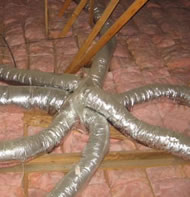|
Building an Energy Efficient Home Custom Search 
Energy Star Homes Anyone building an energy efficient home should give serious consideration to building an Energy Star home. There are several reasons why this financially benefits the homeowner. * Compared with standard homes, Energy Star qualified homes use substantially less energy for heating, cooling, and water heating-delivering $400 to $600 in annual savings. Over the average 7 to 8 years you may live in your home, this adds up to thousands of dollars saved on utility bills. * Additional savings on maintenance can also be substantial since better quality appliances & equipment is installed. * Financing your home purchase using an energy efficient mortgage can also lead to savings. * Some utilities offer a reduction in electricity rates for homes that qualify as Energy Star.
Building an Energy Star home increases its initial cost about 4-8% (depending on materials/equipment installed) which adds some to your mortgage payment, however the reduced utility bills usually will offset any increase in your mortgage payment, therefore your total cost of home ownership does not increase. And as energy costs rise (they always do), your savings increase and Energy Star homes also have higher resale values. "Can you afford NOT to build an Energy Star home?" Other benefits of an Energy Star home include: * Increase comfort/temperatures in your home * Reduced emissions for the environment * Efficient construction techniques and high-performance, better quality products * Improved indoor air quality Features of Energy Star qualified new homes are: * Effective Insulation - Properly installed insulation that meets or exceeds national code requirements helps achieve even temperatures throughout the house while using less energy. The result is lower utility costs and a quieter, more comfortable home. * High-Performance Windows - Advanced window coatings help keep heat in during winter and out during summer. They also block damaging ultraviolet sunlight that can discolor carpets and furniture. * Tight Construction and Tight Ducts - Attention to detail by sealing all holes, cracks, and seams in ducts and construction assemblies helps eliminate drafts, moisture, dust, pests, and pollen. This improves comfort and the quality of indoor air, while lowering maintenance costs. * Energy-Efficient Heating and Cooling Equipment - More efficient and properly sized heating and cooling systems use less energy, which reduces utility bills. These systems also turn on and off less frequently, removing more humidity and providing better comfort. * Efficient Products - Energy Star qualified homes may also be equipped with Energy Star qualified products — lighting fixtures, compact fluorescent bulbs, ventilation fans, and appliances, such as refrigerators, dishwashers, and washing machines. * Third-Party Verification - With the help of independent Home Energy Raters, Energy builder partners choose the most appropriate energy-saving features for their homes. Additionally, raters conduct onsite testing and inspections to verify the energy efficiency measures, as well as insulation, air tightness, and duct sealing details.
|
Building Tip
"Insist your HVAC ductwork be professionally designed. A properly designed system will be more energy efficient since you will be able to use smaller equipment and the home will be more comfortable."

The above picture is an example of a poorly designed duct system and it will not distribute the air properly to the interior rooms.
INSPIRING THOUGHT
“Only those who attempt the absurd can achieve the impossible.”
~ Albert Einstein
